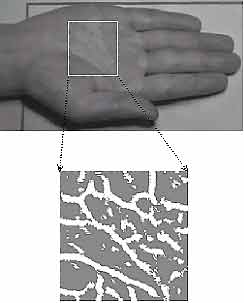
 |
|
|
|
|
|
Fujitsu Develops Biometric Mouse with
|
|
About the Technology Fujitsu's new technology, which it has incorporated into a prototype computer mouse, identifies an individual by the unique pattern of veins in the individual's palm. Palm vein patterns are advantageous for this purpose because they are unique from one person to the next and, except for the size, they do not change as the individual ages. |
 Prototype vein pattern-recognition Biometric mouse |
The authentication process works as follows: The palm is first illuminated by an infra-red light. The veins just beneath the skin of the palm then emit a black reflection, giving a picture of the veins in the palm. Using a proprietary Fujitsu algorithm, a pattern is then extracted from this picture and is checked against patterns stored in the system. If there is a match, the person's identity is confirmed.
In an experiment, carried out by Fujitsu, the vein patterns of about 700 people were stored in a database system, and all were subsequently identified correctly on an individual basis. Fujitsu is confident that it can achieve an equal error rate (*3) of 0.5% or less.
Building the palm vein pattern authentication technology into a computer mouse adds security functionality without interfering with normal operations. The technology can also be built into wall-plates or mobile readers for other applications.

As work on implementing and operating these systems progresses, Fujitsu expects to offer application solutions that will:
Glossary
About Fujitsu
Fujitsu is a leading provider of customer-focused IT and communications solutions for the global marketplace. Pace-setting technologies, high-reliability/performance computing and telecommunications platforms, and a worldwide corps of systems and services experts make Fujitsu uniquely positioned to unleash the infinite possibilities of the broadband Internet to help its customers succeed. Headquartered in Tokyo, Fujitsu Limited (TSE:6702) reported consolidated revenues of 5 trillion yen (about US$38 billion) for the fiscal year ended March 31, 2002. For more information, please see: http://www.fujitsu.com/
| [Press Contacts] Minoru Sekiguchi, Nick Hayashi Public & Investor Relations Tel: +81-3-3215-5259 (Tokyo) Fax: +81-3-3216-9365 |
[Technical Inquiries] Masaki Watanabe Media Solutions Laboratory Information Technology Media Laboratories FUJITSU LABORATORIES LTD. Tel: +81-44-754-2679 (Kawasaki, Japan) Fax: +81-44-754-2347 E-mail: m.watanabe@jp.fujitsu.com |
All company/product names mentioned may be trademarks or registered trademarks of their respective holders and are used for identification purpose only.
Please understand that product prices, specifications and other details are current on the day of issue of the press release, however, may change thereafter without notice.
|
|